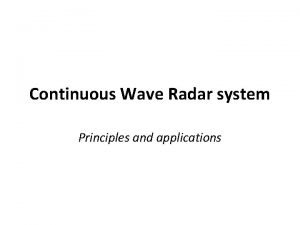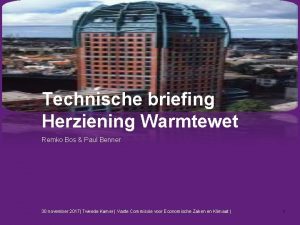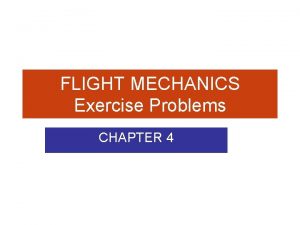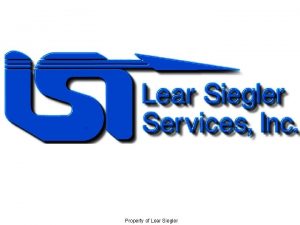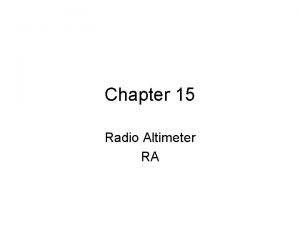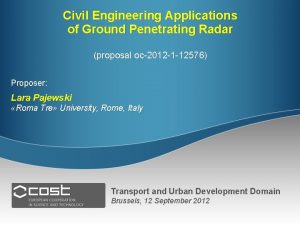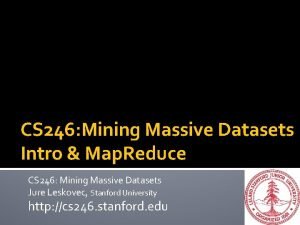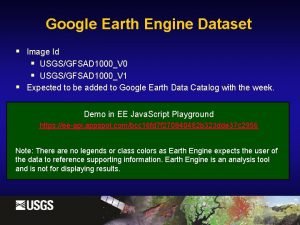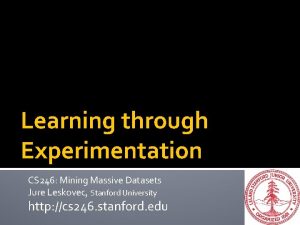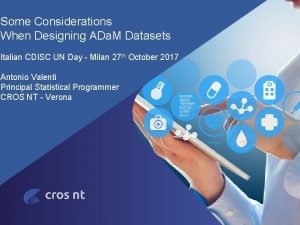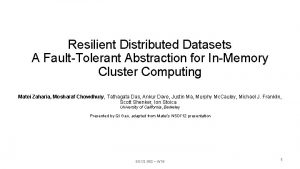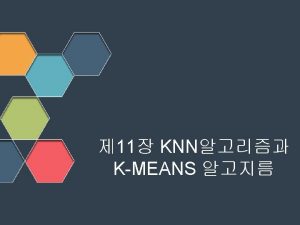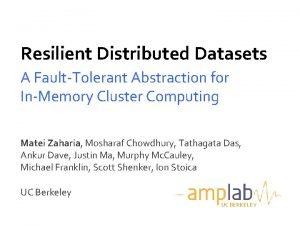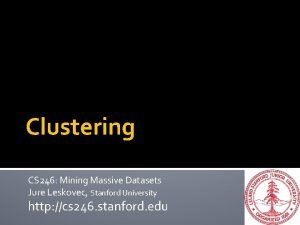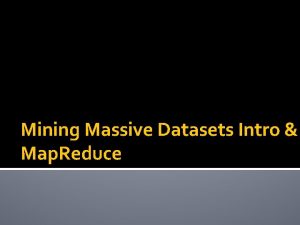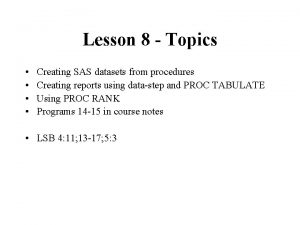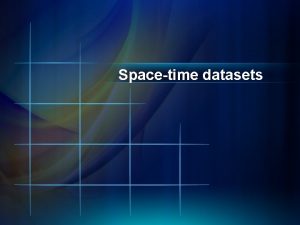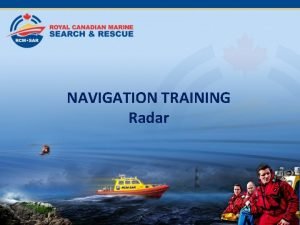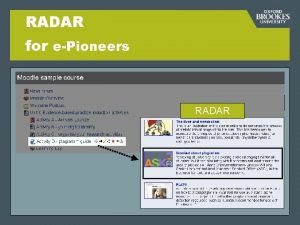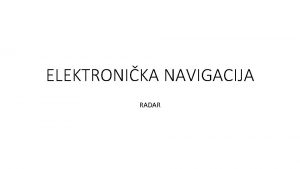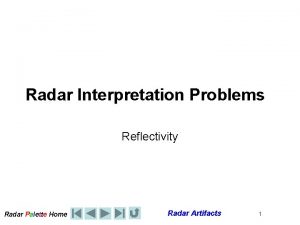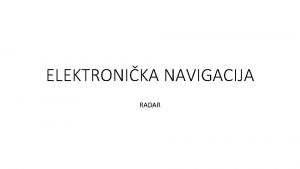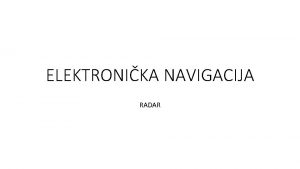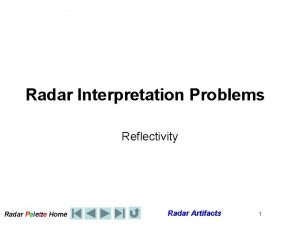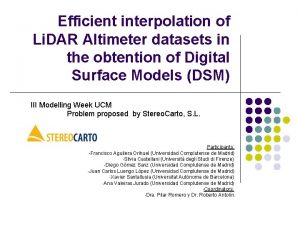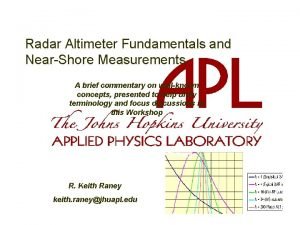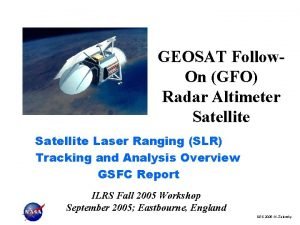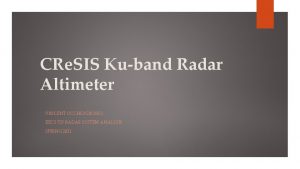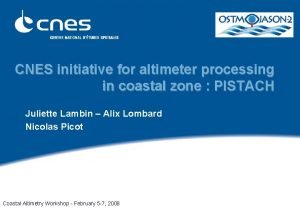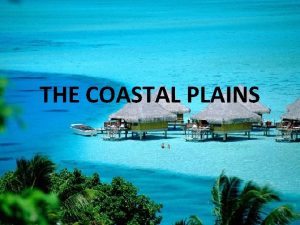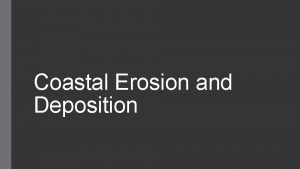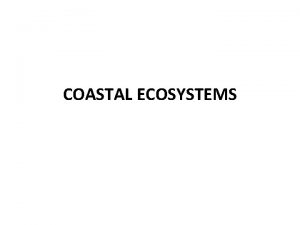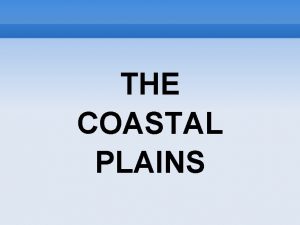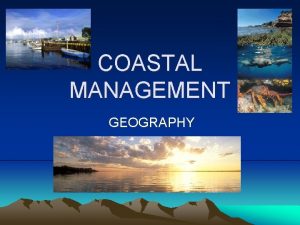Radar Altimeter Datasets for Coastal Applications Remko Scharroo

































- Slides: 33

Radar Altimeter Datasets for Coastal Applications Remko Scharroo, Altimetrics LLC, Cornish, New Hampshire with contributions from Phil Callahan, Franck Mercier, Helen Snaith, Stefano Vignudelli and others Coastal Altimeter Workshop Silver Spring, Maryland, 5– 7 February 2008 Remko Scharroo – Coastal Altimeter Workshop – Silver Spring, Maryland – 5 -7 February 2008

Altimeter Datasets • Geophysical Data Records (GDRs) – Name GDR was inherited from the Seasat mission – Generally meant as archival ocean product – Provided on CD, DVD or FTP by the satellite mission project (NASA/PO. DAAC, CNES/AVISO, IFREMER, NOAA) • Along-track Sea Level Anomaly Products – AVISO has produced on CDs (now FTP) Sea Level Anomaly data sets for TOPEX, ERS, Envisat and Jason-1 – Attempt to provide easy access to altimeter data for ocean apps • Gridded Datasets – Meso-scale and ocean-currents (research and commerce) • On-line Altimeter Databases – RADS, CADS, ACCESS 07 – On-line web interface or off-line mirrored database – Continuously or regularly updated Remko Scharroo – Coastal Altimeter Workshop – Silver Spring, Maryland – 5 -7 February 2008

Geophysical Data Records (GDRs) • Altimeter data and corrections – – – Altimeter range, significant wave height, backscatter coefficient 1 -Hz (mean and standard deviation) and individual 10/20 -Hz Orbital altitude Propagation delay corrections (dry, wet, iono) Ocean interface corrections (sea state bias) Geodetic corrections (tides, mean sea surface, inverse barometer) • Format – Mission-specific, some awkward and ill-designed – Requires specialist knowledge to decipher – Often resistant to expansion (no/few spares) • Content and use – Determined years prior to launch, reluctance to update – No consistency between missions – Aimed at ocean applications (but can be tweaked for coastal) Remko Scharroo – Coastal Altimeter Workshop – Silver Spring, Maryland – 5 -7 February 2008

Along-track Sea Level Anomalies (SLA) • Examples – AVISO/DUACS multi- and mono-mission SLA products • Altimeter data and corrections – Only sea level anomalies (no corrections) – Interpolated to 1 -Hz nodes – All corrections applied, no option to pick and choose • Format CLS is working on a coastal product for Jason-2: PISTACH – Small, easy to use, non-expert user with need for along-track data – FTP, Net. CDF (therefore expandable) – Google Earth • Content and use – – Consistency between missions attempted Updates made occasionally Regional products for N-E Atlantic and Gulf of Mexico Ocean variability, operational oceanography Remko Scharroo – Coastal Altimeter Workshop – Silver Spring, Maryland – 5 -7 February 2008

Prototype Innovant de Système de Traitement pour l’ Altimétrie Côtière et l’ Hydrologie Coastal Altimetry Workshop Silver Spring 5 -7 february 2008

PISTACH products PISTACH, a CNES initiative: see presentation by Nicolas PICOT Objectives: • Definition of Level-2 altimetry products dedicated to coastal zones (and continental hydrology) • implementation of a prototype (must be ready for Jason-2 launch) that integrates new algorithms • generation of the products (I)GDR during 1 year, first products to be delivered in october 2008, before the OSTST. Improvements (wrt Jason-2 regular products) • Local models of tides, DAC, … • Retracking (see slides of Pierre THIBAUT) • Wet tropo (see slides of Estelle OBLIGIS and Franck MERCIER) • SSB (see slides of Sylvie LABROUE) PISTACH products Coastal Altimetry Workshop Silver Spring 5 -7 feb 2008

PISTACH products Format and structure: • Net. CDF, same as Jason-2 regular products • probably 20 Hz sampling instead of 1 Hz • New fields added to the product. • evolution of the regular products Coverage • Distance to shoreline < 200 km • Distance to shoreline < 400 km and bathy > -5000 m • Continental shelves • Specific basins (Med sea, Gulf of Mexico, …) Dissemination Via AVISO PISTACH products Coastal Altimetry Workshop Silver Spring 5 -7 feb 2008

Gridded Sea Level Anomalies (MSLA) • Examples – AVISO/DUACS multi- and mono-mission MSLA products • Altimeter data and corrections – Only sea level anomalies (no corrections) – Gridded to 1ºx 1º or 1/3ºx 1/3º resolution – All corrections applied, no option to pick and choose • Format – Small, easy to use, particularly for those familiar with gridded data – FTP, Net. CDF – Google Earth • Content and use – Several missions combined – Updates made occasionally – Ocean variability, operational oceanography Remko Scharroo – Coastal Altimeter Workshop – Silver Spring, Maryland – 5 -7 February 2008

On-line Databases – RADS - Radar Altimeter Database System (Delft/NOAA) – ADS - Altimeter Data System (GFZ Potsdam) – CADS - Canadian Altimetry Database and Processing Centre (Univ. Calgary) - Under construction – ACCESS 07 - Web based altimeter service (NASA) - Proposed • Altimeter data and corrections – – Everything that’s on the GDR (current at 1 -Hz) More and up-to-date models (tides, propagation corrections) Numerous bugs and anomalies fixed Data calibrated • Format – Proprietary expandable format (now being replaced by Net. CDF) – FTP, rsync • Content and use – All missions; Updates made regularly – Seeks widest possible use (oceanography, coastal, GSLR) Remko Scharroo – Coastal Altimeter Workshop – Silver Spring, Maryland – 5 -7 February 2008

Jet Propulsion Laboratory California Institute of Technology Web-Based Altimeter Service ACCESS 07 Proposal Phil Callahan, PI Brian Wilson, Rob Raskin January 31, 2008 10

Jet Propulsion Laboratory California Institute of Technology Web-Based Altimeter Service Overview • Provide system to allow users to access and combine various parts of altimeter GDRs on demand. – Projects generate fundamental data record from telemetry with time, orbit, instrument information and basic corrections – Producers of other “components” of the altimeter record (see list next page) register products with Altimeter Service • Components can be data or data+operator(s) • Producers need to provide some documentation to guide use • User interaction – – – Login (possible advanced functions: save profile, interests) Select time period, region for product(s) Select components Select delivery method Visualize selected results 11

Jet Propulsion Laboratory California Institute of Technology Web-Based Altimeter Service Main Altimeter Data Components • • • Location kernel: time, latitude, longitude Instrument measurements: fully corrected range, significant wave height (SWH), backscatter coefficient (sigma 0) Instrument-based environmental corrections: radiometer wet troposphere, dual frequency ionosphere Flags, particularly on data quality and usability Parameters that are likely to be replaced by various investigators over time or for specific purposes from the baseline GDR: – – – – • Precision Orbit altitude (every frame, or approximately every second) Elastic ocean tide Mean Sea Surface or Geoid (reference surface) Dry troposphere correction Inverse barometer/barotropic correction Electromagnetic/Sea State Bias correction Pole Tide Detailed ancillary data that are not needed for most investigations. 12

Jet Propulsion Laboratory California Institute of Technology Web-Based Altimeter Service Some Usage Scenarios • Basic altimeter data records: Project produces initial IGDR; all subsequent updates done with service – add POD, improved atmospheric models (observed replaces predict), any other improvements available on ~1 month time scale • Model improvements/updates: Particularly revised orbits, improved tides , radiometer calibrations, barotropic corrections, geoid, mean sea surface • Regional/coastal products: Local tide models, radiometer corrections (processed to remove land effects), local barotropic models – Special retracking could be linked to original points • Storm products: Time/space subsetting, special tropo models 13

Jet Propulsion Laboratory California Institute of Technology Web-Based Altimeter Service Implementation Issues • Modularization of GDR processing – Remote callable; separation of processing and data – Bandwidth for distributing waveform data; specialize retracking • Registration of Data Components – Generators need to cooperate by providing information to the central server, making data available routinely, continuously • Registration of Models and Operators – Information as for data plus remote callable software – Where is processing done? • Flagging – is there interaction among components that needs to be considered in generating flags? • Documentation of data and models – Usage guidance, caveats – Error analysis 14

what we need from coastal altimeter data. . . and why we don’t get it at the moment

We Need • All parameters (Height, SWH, wind speed) • All corrections (instrumental, path delay, tides, geoid) • Highest spatial resolution => 10/20 Hz • Precise geolocation

How will data be used • Without assimilation? • Unlikely • Gridded products? • • • Easy to assimilate Can they capture variability? High level pre-assimilated solutions • Along track

Coastal specific processing • Waveform tracking for SSH • • effects of varying topography & geometry stay locked on sea surface • SWH • Change in wave spectra • change in distribution of scatterers • Wind Speed

Corrections • • • Instrumental • In theory - the same! Tides • • High spatial & temporal frequency Surges Geoid & Mean Sea Surface Short wavelengths significant Cross-track separation ≈ along-track

Corrections • Atmospheric • • • High spatial resolution changes Interpolation of large grid not enough Measured wet trop not yet “fixable” • Ionospheric • • Dual frequency -> retrack second waveform Extrapolate to coast -> model may be better

Regional Plug-ins • Corrections cannot be calculated globally • Models for “global coast” do not exist • Use regional plug-in data • • • Tides & high frequency reponses Geoid & MSS Atmospheric (profiles & analysis)

RADS • Probably closest in strategy • Provides consistent database, including all corrections, in consistent format, for all altimeter missions • Common meta file format (description of data, scale, offset, and constants) • Along track ie highest spatial resolution

Advantages • All parameters - not just Surface Height • Geophysical corrections and reference frame common to all altimeters • Selection of correction and quality control criteria at time of selection • Preferences controlled by user • Ultra-flexible file augmentation

GDR data • Higher level GDR data • widely available but don’t fit the bill • 10/20 Hz values only available for SSH (& sometimes SWH) • No consistency across altimeters

Geosat GM mission • Data available from NOAA • • parameters from 4 different retracker results All data and corrections at 10 Hz

Web Services • Make use of protocols to allow access to services. • Similar to program function calls. • Client accesses a web service using a recognised call • web service returns the required information in standard manner

Why Bother? • Allow access to data or services WITHOUT exposing the host system • e. g. allow access to data without needing full userid access • Allows “simple” machine - machine access • eg - access data on remote sites from within matlab code

Example: download with real-time check (for instance in an environmental crisis, when ‘latest model’ is ‘update’ ‘select’ essential)‘get’ (My. SQL) ‘get’ ‘check_upd’

Example: download with real-time check (for instance in an environmental crisis, when ‘latest model’ is essential) Net. CDF Files open. DAP server

File-based architecture 1: precomputation of corrected params • 1. SLAs (+ SWH, wind speed) are precomputed offline from raw data + corrections and stored 2. When user asks for data, the OPe. NDAP server serves the precomputed SLAs Raw data Net. CDF corr 1 corr 2 corr 3 Preprocessor SLA, SWH Net. CDF OPe. NDAP server PROs: simple, no extra client required CONs: allows only predefined correction schemes USER running standard OPe. NDAP client

File-based architecture 2: computation at the user • The user runs a specialized client which gets raw data + corrections via the OPe. NDAP server and computes the parameter Raw data Net. CDF corr 1 corr 2 corr 3 OPe. NDAP server PROs: trivial to setup on server side CONs: needs separate, non-standard user clients for each application (they can be implemented with a range of software tools sitting on top of the standard OPe. NDAP client) Custom client USER IGARSS 2007 Barcelona 23 -27 July 2007 P. Cipollini /24

File-based architecture 3: “on the fly” computation • The request from the user to the OPe. NDAP server prompts an interface server that retrieves the raw data and corrections and computes the parameter on the fly Raw data Net. CDF corr 1 corr 2 corr 3 Interface server OPe. NDAP server PROs: request is fully customizable CONs: interface server needs to be implemented and be able to interpret OPe. NDAP request - CDAT is a possible candidate IGARSS 2007 Barcelona 23 -27 July 2007 P. Cipollini USER running standard OPe. NDAP client /24

For Discussion • What products do we need? – – – – Data frequency: 1 -Hz, 10/20 -Hz, other? Data corrections: Best available, Up-to-date? Data sampling: Along-track, Gridded? Data volume: Global, Regional? Data format: GDR, Net. CDF? Data access: DVD, CD, FTP, Web? Data latency: days, weeks, months? • What service provides this now? Remko Scharroo – Coastal Altimeter Workshop – Silver Spring, Maryland – 5 -7 February 2008
 Radar altimeter
Radar altimeter Remko bos
Remko bos Remko bos
Remko bos An mti radar that uses amplitude fluctuations is
An mti radar that uses amplitude fluctuations is Mti vs pulse doppler radar
Mti vs pulse doppler radar Consider a mach 4 airflow at a pressure of 1 atm. we wish
Consider a mach 4 airflow at a pressure of 1 atm. we wish Lear siegler b0245 81110 airspeed indicator
Lear siegler b0245 81110 airspeed indicator Radio altimeter
Radio altimeter Civil engineering applications of ground penetrating radar
Civil engineering applications of ground penetrating radar Cs 246: mining massive data sets
Cs 246: mining massive data sets Myafsaccount
Myafsaccount Stanford mining massive datasets
Stanford mining massive datasets Adsl dataset example
Adsl dataset example Resilient distributed datasets
Resilient distributed datasets Sklearn.datasets.samples_generator
Sklearn.datasets.samples_generator Iteratrion
Iteratrion Cs 246 stanford
Cs 246 stanford Mining of massive datasets solution
Mining of massive datasets solution Proc datasets noprint
Proc datasets noprint Indikation för kejsarsnitt på moderns önskan
Indikation för kejsarsnitt på moderns önskan Datorkunskap för nybörjare
Datorkunskap för nybörjare Delegerande ledarstil
Delegerande ledarstil Toppslätskivling dos
Toppslätskivling dos Ekologiskt fotavtryck
Ekologiskt fotavtryck Redogör för vad psykologi är
Redogör för vad psykologi är Geometriska former i förskolan
Geometriska former i förskolan Claes martinsson
Claes martinsson Bra mat för unga idrottare
Bra mat för unga idrottare Etik och ledarskap etisk kod för chefer
Etik och ledarskap etisk kod för chefer Svenskt ramverk för digital samverkan
Svenskt ramverk för digital samverkan Upprepning dikt
Upprepning dikt Tidbok yrkesförare
Tidbok yrkesförare Antika plagg
Antika plagg Kontinuitetshantering i praktiken
Kontinuitetshantering i praktiken
